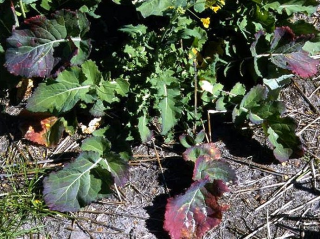Green peach aphid and turnip yellow virus update
- Northam
- Toodyay
- Gibson
- Kendenup
- Woogenellup
- Takalarup

The Department of Primary Industries and Regional Development’s (DPIRD) monitoring of green peach aphid (GPA) activity at sites in the Kwinana West, Albany and Esperance region continues. Yellow sticky traps have been put on fencelines to catch migrating aphids, and DPIRD staff are also conducting crop inspections and virus testing of captured aphids and inspected crops.
Winged GPA have recently been caught on traps set up at Northam and Toodyay. They have also been found infesting some crops in this area. These crops are being testing for presence of turnip yellows virus (TuYV) which is transmitted by GPA, and can cause up to 50% yield losses when the crop becomes infected during the vegetative growth stage.
GPA have also been found infesting crops at various sites in the Albany port zone. TuYV has been detected in flying aphids caught on sticky traps in Gibson, but the presence of GPA has not been confirmed.
Therefore, growers/advisors in the Kwinana West, Esperance and Albany port zones should be monitoring young crops over the next couple of weeks.

DPIRD is not monitoring crops in the Geraldton or Kwinana East port zones. Therefore, if growers or agronomists operating in these regions observe aphid infestation or virus-like symptoms in crops, please contact DPIRD Research Scientist Benjamin Congdon on +61 (0)8 9368 3499. Canola plants can also be tested for the presence of virus through the Department’s Diagnostic Laboratory Services – Pathology Services.
The aphid population growth rate is likely to have been reduced due to the recent cold conditions. Additionally, when temperatures drop below 16°C, aphids are unlikely to fly, which decreases the probability of widespread virus infection caused by them. Furthermore, heavy rain can cause aphid mortality as it dislodges aphids from plants. However, if daytime temperatures exceed 16°C in the coming weeks, aphid populations in certain areas where they are already present will continue to grow and disperse. This may pose a risk to crops that are still in their vulnerable growth phase (pre-flowering). Crops that have begun stem elongation and are aphid and virus free are now in the safe zone. The use of insecticides to control certain aphid/virus combinations (such as cereal aphids/yellow dwarf viruses and GPA/TuYV) in these more mature crops is unlikely to provide any economic benefits.
For insecticide recommendations refer to DPIRD’s 2023 winter spring insecticide guide.
To read about earlier aphid and TuYV activity this season refer to the 2023 PestFacts WA Issue 6 article Green peach aphid alert and Issue 5 article Early season aphid and virus risk in cereals and canola.
For more information refer to DPIRD’s Turnip yellows virus early warning system page and Turnip yellows virus in canola: diagnosis and management page.
For further information contact Research scientist Benjamin Congdon, South Perth on +61 (0)8 9368 3499.
Article author: Benjamin Congdon (DPIRD South Perth).
